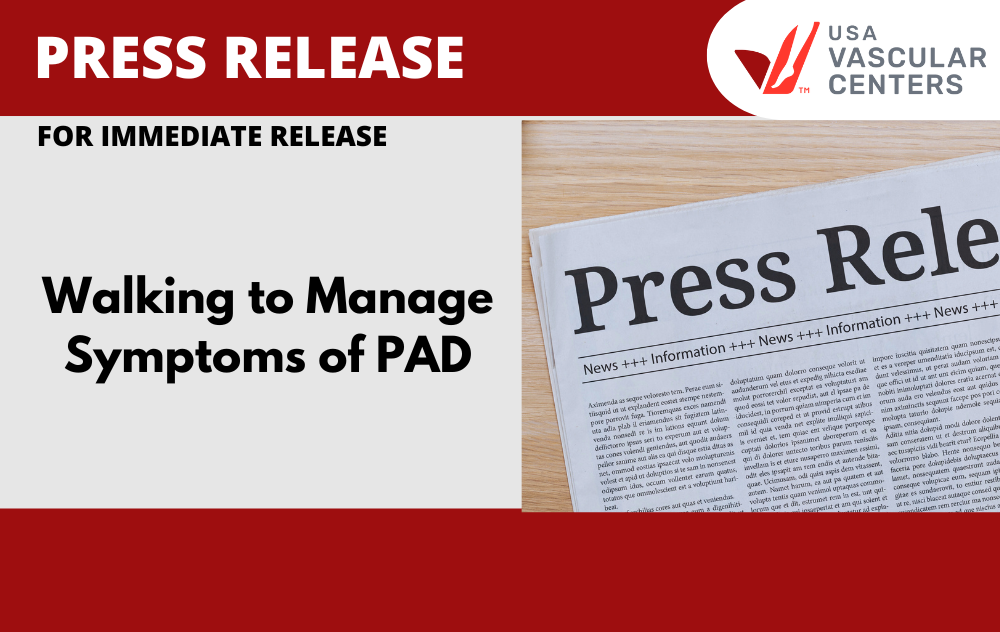Northbrook, IL, August 17, 2021 – Physicians at USA Vascular Centers recommend walking to help patients manage the symptoms of peripheral artery disease (PAD), which impacts approximately 8 million people aged 40 and older in the United States. People with PAD have blockages in their arteries that slow or stop the blood flood flow to their legs. As a result, they have pain and difficulty walking even short distances. It is comparable to angina for people who have symptomatic heart disease. Few therapies exist to treat it.
Walking is a low-impact form of exercise that can raise the heart rate. It improves symptoms of PAD by promoting increased blood flow to the lower extremities. This increased blood flow provides reoxygenation of undernourished leg muscles, which helps alleviate painful PAD claudication. Although walking in any form is believed to help improve PAD symptoms, most research has focused on the benefits of supervised treadmill exercise.
Supervised treadmill exercise has been shown to improve both pain-free and maximal walking distance. One study1 revealed that supervised walking improved pain-free walking distance by 128 meters and maximal walking distance by 180 meters, relative to the control group.
Effective programs typically begin by prescribing 30 minutes or more of walking each day, at least three times per week. Over time, patients should work their way up to 60 minutes each day, five days a week. Symptomatic improvement should occur within three to six months of regular exercise.
“Research has identified that walking at any pace is better than no exercise at all,” said Aaron Shiloh, M.D., USA Vascular Centers. “Walking is widely acknowledged as the best form of exercise to improve cramping pain in the legs, the most reported symptoms of PAD.”
If patients are unable to participate in supervised treadmill exercise, they can follow established guidelines for a safe, self-guided walking program. It may be helpful to use wearable technology to track steps and distance. In addition to the clear benefits of walking for PAD, there is growing evidence that lower-extremity resistance training can improve functional performance as measured by treadmill walking, stair climbing ability, and quality of life.
While many forms of exercise can be beneficial, it is important to note that some should be avoided. These include high-intensity activities that place undue strain on the heart or brain, along with those involving extensive footwork such as climbing or dancing.
Numerous other lifestyle modifications can improve PAD pain and discomfort. For instance, maintaining a healthy BMI, eating a well-balanced diet, and quitting smoking may help provide symptomatic relief. Additionally, medications intended to lower blood pressure, manage cholesterol levels, control blood sugar, and lower the risk of blood clots are often prescribed to individuals with PAD.
In cases of advanced PAD, a revascularization procedure may be beneficial. Depending on the severity and location of atherosclerosis, a vascular specialist may recommend performing angioplasty, stent placement, or atherectomy to improve blood flow to the affected region.
“A range of effective minimally invasive PAD treatment options exist that can improve the situation,” said Shiloh. “A vascular specialist can make personalized recommendations based on a patient’s medical history and the severity of their condition.”
For more information about USA Vascular Centers, or to book a consultation, call 888-773-2193 or visit www.usavascularcenters.com.
Resource:
About USA Vascular Centers
USA Vascular Centers are dedicated to the minimally invasive, non-surgical treatment of various conditions, including peripheral artery disease (PAD). USA Vascular Clinics locations include New York, West Virginia, California, New Jersey, Florida, Georgia, Pennsylvania, Massachusetts, Illinois, Washington and Texas. At USA Vascular Centers, highly trained vascular surgeons with decades of experience perform minimally invasive treatments for vascular diseases that used to require surgery and a hospital stay. For information or to refer a patient, visit www.usavascularcenters.com.

